

RPS5-Mediated Disease Resistance: Fundamental Insights and Translational Applications. 2020.04.10.034173v2. Annurev phyto 010820 012733. 2020.01.12.903575v1. 2020.01.12.903575v1. Genome-wide expression analysis of immune receptors in hot pepper reveals an autonomous NLR cluster in higher plants. SnRK2 protein kinases and mRNA decapping machinery control root development and response to salt. A Coevolved EDS1-SAG101-NRG1 Module Mediates Cell Death Signaling by TIR-Domain Immune Receptors. Arabidopsis PAD4 lipase-like domain is a minimal functional unit in resistance to green peach aphid. Genome Sequence of Striga asiatica Provides Insight into the Evolution of Plant Parasitism. The large repertoire of conifer NLR resistance genes includes drought responsive and highly diversified RNLs.
Mannan oligosaccharides trigger multiple defence responses in rice and tobacco as a novel danger‐associated molecular pattern - Zang - 2019 - Molecular Plant Pathology. Introduction Unlike vertebrate animals, plants rely entirely on an innate immune system for their resistance against various pathogens.

Plant innate immune response has two layers: pattern‐triggered immunity (PTI) and effector‐triggered immunity (ETI) (Chisholm et al., 2006; Jones and Dangl, 2006). The first layer immune response is initiated by recognition of microbe or modified plant‐derived molecules such as flagellin, lipopolysaccharides, chitin, and oligogalacturonides (OGAs) through pattern‐recognition receptors (PRRs) located on the cell membrane (Hayafune et al., 2014; Zipfel et al., 2004). Oligosaccharides are low molecular weight saccharide polymers with degrees of polymerization (DP) between 2 and 10, mainly derived from plant cellulose or hemicellulose like pectins, xyloglucans, cellodextrins etc. In our previous study, we identified a novel thermostable mannanase BpMan5, which was encoded by Bacillus pumilus GBSW19 (Zang et al., 2015). Results Discussion H2O2 assay. Cellular Tracking and Gene Profiling of Fusarium graminearum during Maize Stalk Rot Disease Development Elucidates Its Strategies in Confronting Phosphorus Limitation in the Host Apoplast.
Citation: Zhang Y, He J, Jia L-J, Yuan T-L, Zhang D, Guo Y, et al. (2016) Cellular Tracking and Gene Profiling of Fusarium graminearum during Maize Stalk Rot Disease Development Elucidates Its Strategies in Confronting Phosphorus Limitation in the Host Apoplast.
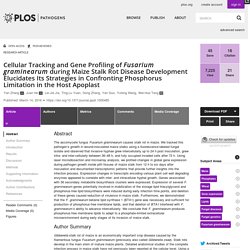
PLoS Pathog 12(3): e1005485. Editor: Bart Thomma, Wageningen University, NETHERLANDS Received: June 25, 2015; Accepted: February 10, 2016; Published: March 14, 2016 Copyright: © 2016 Zhang et al. This is an open access article distributed under the terms of the Creative Commons Attribution License, which permits unrestricted use, distribution, and reproduction in any medium, provided the original author and source are credited. Data Availability: All microarray files are available from the GEO database (accession number GSE53854). Competing interests: The authors have declared that no competing interests exist. Introduction Results Fusarium graminearum hyphae first grow intercellularly and later intracellularly Fig 1. Fig 2. F. F. The plant hypersensitive response: concepts, control and consequences - Balint‐Kurti - - Molecular Plant Pathology. HR control mediated through NLR expression and protein accumulation HR needs to be tightly regulated.
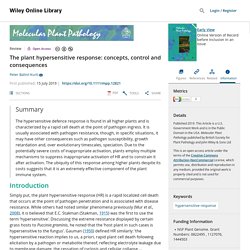
It must be completely suppressed under non‐disease conditions since improper activation will lead to a spontaneous cell death phenotype which can be very detrimental to plant growth (e.g. Genome-wide functional analyses of plant coiled–coil NLR-type pathogen receptors reveal essential roles of their N-terminal domain in oligomerization, networking, and immunity. The Arabidopsis Pleiotropic Drug Resistance Transporters PEN3 and PDR12 Mediate Camalexin Secretion for Resistance to Botrytis cinerea. An EDS1-SAG101 Complex is Essential for TNL-mediated Immunity in Nicotiana benthamiana. Plant–necrotroph co-transcriptome networks illuminate a metabolic battlefield. A central goal of studying host-pathogen interaction is to understand how host and pathogen manipulate each other to promote their own fitness in a pathosystem.
Co-transcriptomic approaches can simultaneously analyze dual transcriptomes during infection and provide a systematic map of the cross-kingdom communication between two species. Here we used the Arabidopsis-B. cinerea pathosystem to test how plant host and fungal pathogen interact at the transcriptomic level. We assessed the impact of genetic diversity in pathogen and host by utilization of a collection of 96 isolates infection on Arabidopsis wild-type and two mutants with jasmonate or salicylic acid compromised immunities.
We identified ten B. cinerea gene co-expression networks (GCNs) that encode known or novel virulence mechanisms. Identification of a gene cluster for the synthesis of the plant hormone abscisic acid in the plant pathogen Leptosphaeria maculans. JavaScript is disabled on your browser.
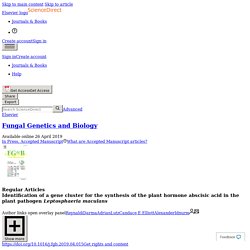
Please enable JavaScript to use all the features on this page. Highlights A gene cluster is upregulated in L. maculans in its biotrophic stage of disease. Transcription factor Abl7 regulates six genes in the gene cluster. The gene cluster has a role in synthesizing plant hormone abscisic acid. Deletion of two genes has no major impact on pathogenicity. Abstract. Help wanted: helper NLRs and plant immune responses. Arabidopsis thionin-like genes are involved in resistance against the beet-cyst nematode (Heterodera schachtii) JavaScript is disabled on your browser.
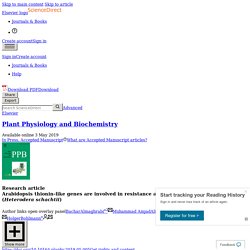
Please enable JavaScript to use all the features on this page. Highlights. The hypersensitive induced reaction 3 (HIR3) gene contributes to plant basal resistance via an EDS1 and salicylic acid‐dependent pathway - Li - 2019 - The Plant Journal. DNA Repair Gene ZmRAD51A Improves Rice and Arabidopsis Resistance to Disease. Genes involved in nonhost disease resistance as a key to engineer durable resistance in crops. Plant-necrotroph co-transcriptome networks illuminate a metabolic battlefield. Plant Immunity: Thinking Outside and Inside the Box: Trends in Plant Science.
Subsets of NLR genes show differential signatures of adaptation during colonisation of new habitats - Stam - Nucleotide binding site, Leucine‐rich repeat Receptors (NLRs), are canonical resistance (R) genes in plants, fungi and animals, functioning as central (helper) and peripheral (sensor) genes in a signalling network.
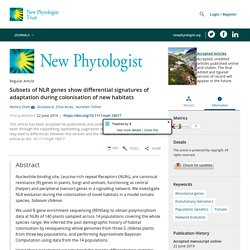
We investigate NLR evolution during the colonisation of novel habitats in a model tomato species, Solanum chilense. We used R‐gene enrichment sequencing (RENSeq) to obtain polymorphism data at NLRs of 140 plants sampled across 14 populations covering the whole species range. We inferred the past demographic history of habitat colonisation by resequencing whole genomes from three S. chilense plants from three key populations, and performing Approximate Bayesian Computation using data from the 14 populations. Using these parameters we simulated the genetic differentiation statistics distribution expected under neutral NLR evolution, and identified small subsets of outlier NLRs exhibiting signatures of selection across populations.
This article is protected by copyright. Of PAMPs and Effectors: The Blurred PTI-ETI Dichotomy. Plant mixed lineage kinase domain-like proteins limit biotrophic pathogen growth. Plant mixed lineage kinase domain-like proteins limit biotrophic pathogen growth. Natural variation for unusual host responses and flagellin‐mediated immunity against Pseudomonas syringae in genetically diverse tomato accessions - Roberts - 2019.